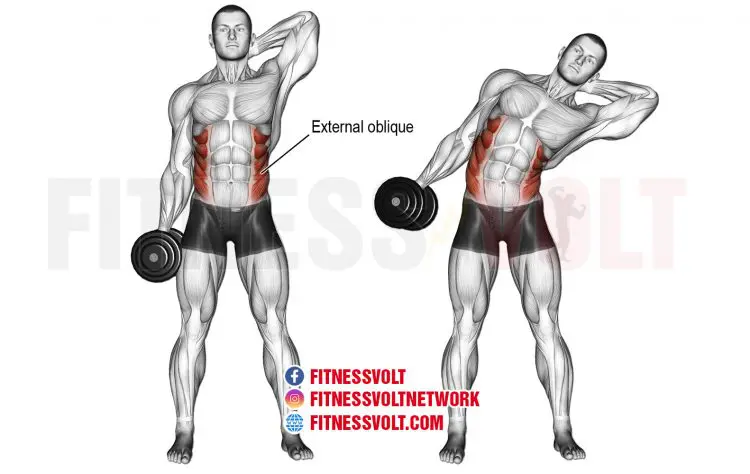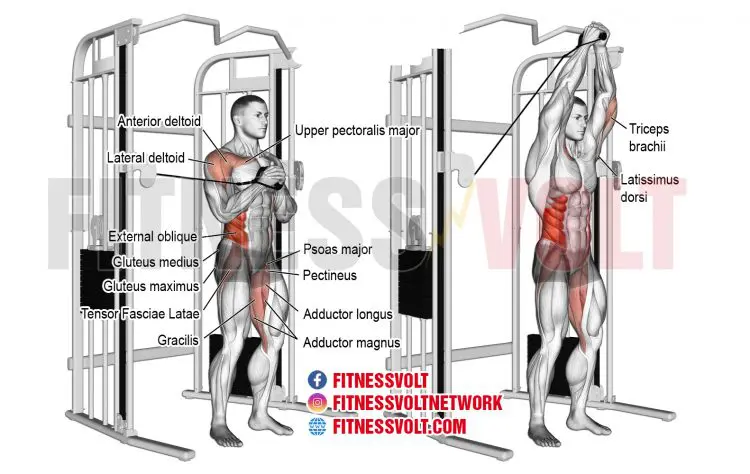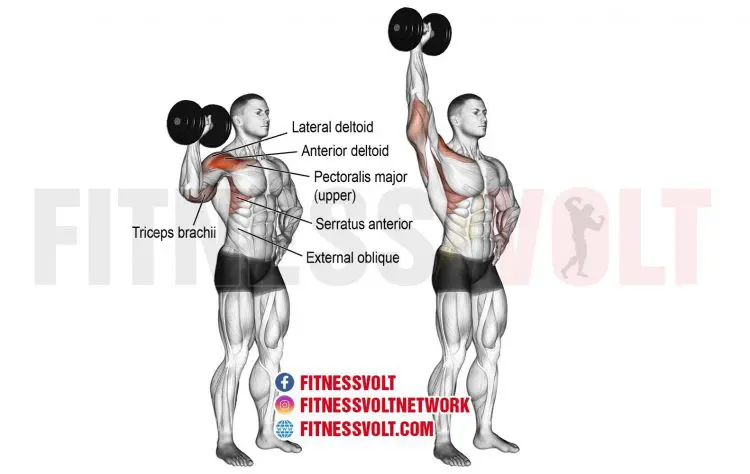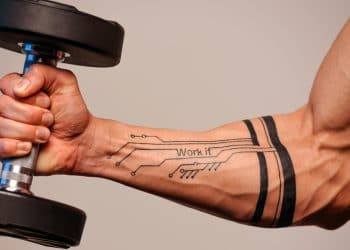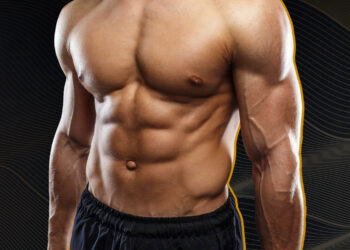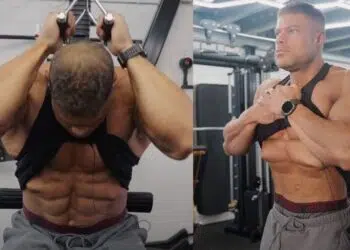You need a great set of abs if you want to look awesome naked. That’s why so many people include exercises like crunches, planks, and sit-ups in their workouts, do cardio, and watch what they eat.
As a veteran personal trainer with over 35 years of experience, I can attest that many lifters train their abs very differently from how they work the rest of their body. For example, instead of doing two to four sets of eight to 12 reps with a challenging load, they do hundreds of reps with low resistance and work their abs daily.
This makes no sense! The abs are just like every other muscle group. You wouldn’t bench press 45 pounds for 100 reps five or seven days a week to build your chest, so why do that with your abs?
If you want your abs to show, you need to lose body fat and make them thicker and more prominent. The best way to induce abdominal wall hypertrophy is to drop the high-rep and low-resistance training and start doing weighted abs exercises.
In this article, we reveal the 14 best-weighted abs exercises and provide you with a couple of workouts to try.
Level Up Your Fitness: Join our 💪 strong community in Fitness Volt Newsletter. Get daily inspiration, expert-backed workouts, nutrition tips, the latest in strength sports, and the support you need to reach your goals. Subscribe for free! Recent Updates: On June 11, 2024, Fitness Volt’s Senior Editor, Vidur Saini (American Council on Exercise-CPT), updated the article and added actionable expert tips throughout the piece to improve the reader experience.
14 Best Weighted Abs Exercises
Build stronger, thicker abs for a more prominent six-pack with these weighted abdominal exercises!
- Weighted Hanging Knee Raise
- Weighted Plank
- Weighted Stability Ball Crunch
- Cable Crunch
- Weighted Ab Wheel Rollout
- Weighted V-Sit
- Single-Arm Farmer’s Walk
- Weighted Russian Twist
- Weighted Windshield Wiper
- Cable Woodchop
- Weighted Side Bend
- Pallof Cable Press
- Single-Arm Overhead Press
- Weighted Saxon Side Bend
1. Weighted Hanging Knee Raise
| Sets & Reps | 3 x 8-12 (or to failure) |
| Equipment Needed | Pull-up bar, dumbbell, or ankle weights |
| Target Muscles | Primarily rectus abdominis, also hip flexors |
Hanging knee raises are already a great abs exercise, but they’re even better with weight. Save yourself from doing high-rep sets by clamping a dumbbell between your feet or wearing ankle weights. Do this exercise by hanging from a pull-up bar or using a captain’s chair.
A brief pause at the top of your range of motion (ROM) significantly increases time under tension, promoting greater muscle fiber recruitment, says Saini.
How to do it:
- Hang with your legs straight, and core braced.
- Flex your hips, bend your knees, and raise your legs until they are slightly above parallel to the floor. Do not swing your legs up. Instead, move slowly to minimize momentum and keep the tension on your abs.
- Tip the bottom of your pelvis forward, shortening the distance between your hips and sternum, to fully engage your abs.
- Lower your legs and repeat.
- Make this exercise a lot harder by extending your legs and keeping them straight.
Pro Tip: Don’t just raise your knees; initiate the movement by tilting your pelvis upwards for a deeper target muscle engagement.
| Difficulty | Intermediate |
| Progression | Hanging straight leg raise, toes-to-bar, windshield wipers, weighted toes-to-bar |
| Regression | Hanging knee raise (no weight), knee tucks on a Roman chair or incline bench |
2. Weighted Plank
| Sets & Reps | 3-4 sets, 30-60 seconds (or to failure) |
| Equipment Needed | Weight plate or dumbbell (optional) |
| Target Muscles | Rectus abdominis, transverse abdominis, obliques, serratus anterior, shoulders, glutes |
Planks are great for working your anterior core, but doing planks for minutes at a time is inefficient and ineffective. You’ll get a lot more from this exercise if you do it with some additional load.
Saini suggests using slow, controlled breathing to amplify core activation. Inhale deeply to expand your abdomen, then exhale forcefully while maintaining a rigid plank position.
How to do it:
- Kneel down and place your forearms on the floor, hands together and extended in front of you.
- Walk your feet out and back, so your legs and body are straight. Brace your core.
- Ask a training partner to gently place the required amount of weight on your lower back.
- Without dropping your hips, maintain this position for 20-30 seconds. If you can hold for longer, you need to use more weight.
- Get your partner to remove the weight at the end of your set.
Pro Tip: Contract your glutes and quads to create a strong, stable foundation that allows your core to work harder and prevents sagging in the lower back.
| Difficulty | Beginner (unweighted) to advanced (weighted) |
| Progression | Increase hold time, add weight, perform plank variations like plank shoulder taps or plank reaches |
| Regression | Standard plank on knees, plank on an incline |
3. Weighted Stability Ball Crunch
| Sets & Reps | 3 x 10-15 |
| Equipment Needed | Stability ball, dumbbell, or weight plate |
| Target Muscles | Rectus abdominis, obliques |
Crunches are a popular abs exercise but can also be ineffective if you are strong enough to do 20 or more reps without too much effort. Adding weight and increasing the range of motion with a stability ball makes this classic ab exercise much more effective.
Saini urges experimenting with different foot placements. Wider foot placement will challenge your balance and stability, further engaging your core muscles.
How to do it:
- Sit on a stability ball and hold a weight plate in your hands.
- Walk your feet forward and lean back until the ball fills the natural curve of your lumbar spine. Position the weight plate on your chest.
- Depending on how much weight you are using, you may also need to brace your feet against an immovable object, such as the bottom of a wall.
- Flex your spine and curl your shoulders toward your hips. Tense your abs as hard as possible at the top of each rep.
- Lean back, stretch your abs and repeat.
- Make this exercise more challenging by holding the weight behind your head.
Pro Tip: Control the eccentric (lowering) phase of the movement to increase the TUT and maximize muscle stimulation.
| Difficulty | Beginner to Intermediate |
| Progression | Increase weight, perform decline stability ball crunch |
| Regression | Stability ball crunch (no weight), crunches on the floor |
4. Cable Crunch
| Sets & Reps | 3 x 12-15 |
| Equipment Needed | High pulley cable machine, rope attachment |
| Target Muscles | Rectus abdominis, obliques |
The great thing about cable crunches is how easy they make loading your abs. Just move the pin on the weight stack up or down as needed.
This makes cable crunches ideal for muscle-building drop sets. Do a heavy set, lower the weight by 10-15 percent, and then rep out again. This technique allows you to train past your usual failure point.
How to do it:
- Attach a rope handle to a high cable machine. Hold one end in each hand and then kneel down. Pull the handles down to your shoulders, and then keep them there for the duration of your set.
- Bending your spine rather than your hips, pull your shoulders down toward your pelvis, forming a C-shape with your upper body.
- Return to the starting position, getting a good stretch in your abs, and repeat.
- You can also do this exercise while standing.
Pro Tip: Experiment with different cable attachments. A rope attachment allows for a greater range of motion, while a D-handle might provide a more focused contraction.
| Difficulty | Beginner to Intermediate |
| Progression | Increase weight, perform kneeling cable crunches, decrease rest time between sets |
| Regression | Crunches on the floor, use a resistance band instead of cable machine |
5. Weighted Ab Wheel Rollout
| Sets & Reps | 3 x 6-10 (or to failure) |
| Equipment Needed | Ab wheel, weight plate (optional) |
| Target Muscles | Rectus abdominis, transverse abdominis, obliques, serratus anterior, lats |
Ab wheel rollouts are already a challenging exercise, but they’re even harder if you wear a weighted vest. A little load goes a long way with this exercise, so start light and increase the weight gradually. Five to 10 percent of your body weight is a good starting point for most people.
“The key to this exercise is controlled deceleration,” says Saini. Resist the urge to rush as you return to the starting position. A slow, deliberate return builds eccentric strength and minimizes injury risk.
How to do it:
- Wearing your weighted vest, kneel down and place your ab wheel on the floor in front of you. Brace your core.
- Keeping your arms straight, extend your hips and push the wheel away from you, lowering your chest and abdomen down toward the floor. Take care not to arch your lower back.
- Pull yourself back to the starting position and repeat.
- You can also do this exercise with a barbell — making them even harder.
Pro Tip: Initiate the movement by bracing your core and rounding your upper back slightly to protect your lower back and keep the tension on your abdominals throughout the rollout.
| Difficulty | Advanced |
| Progression | Increase the range of motion by rolling out further, perform the rollout from a standing position |
| Regression | Ab wheel rollout from knees (no weight) |
6. Weighted V-Sit
| Sets & Reps | 3 x 15-20 seconds (or to failure) |
| Equipment Needed | Dumbbell or weight plate (optional) |
| Target Muscles | Rectus abdominis, hip flexors, obliques |
The V-sit combines a leg lift and an upper body crunch, making it an effective total abs exercise. However, it’s also pretty challenging, so master the movement mechanics before trying the weighted variation.
“Don’t overemphasize the ‘V’ shape. Instead, focus on maintaining a hollow body position throughout the hold,” says Saini.
How to do it:
- Lie on your back with your legs straight and arms above your head. Hold a weight plate, medicine ball, or single dumbbell in your hands. Brace your abs.
- Keeping your arms and legs straight, raise both ends of your body and reach up toward your feet, so your body forms a V-shape.
- Lie back down flat on the floor and repeat.
Pro Tip: Keep your core braced throughout the ROM for maximal target muscle recruitment.
| Difficulty | Intermediate |
| Progression | Increase hold time, add weight, perform L-sit or V-ups |
| Regression | V-sit (no weight), tucked V-sit, shorter hold time |
7. Single-Arm Farmer’s Walk
| Sets & Reps | 3-4 sets per arm, 20-30 yards |
| Equipment Needed | Heavy dumbbell or kettlebell |
| Target Muscles | Forearms, core, traps, shoulders, glutes, quadriceps |
Farmer’s walks are usually thought of as a grip or conditioning exercise. While that’s very much the case, doing this exercise with one arm turns it into an excellent lateral abdominal exercise. You’ll need to use your entire core to keep your torso upright.
Saini recommends using lifting straps to eliminate your grip strength if that is a limiting factor.
How to do it:
- Hold a heavy dumbbell or kettlebell down by your side.
- Walk around your training area until you cannot keep your torso straight or your forearms start to fail.
- Put the weight on the floor, swap hands, and repeat.
- You can also do this exercise with your arm raised above your head. This is called a waiter’s walk. The waiter’s walk challenges shoulder stability as well as working your core.
Pro Tip: Keep your shoulders pulled down and back to ensure that your core and lats are doing most of the work.
| Difficulty | Intermediate to Advanced |
| Progression | Increase weight, distance, or walking speed. Use a heavier object like a sandbag or kettlebell. |
| Regression | Use a lighter weight, shorten the distance, perform with both hands |
8. Weighted Russian Twist
| Sets & Reps | 3 x 15-20 (each side) |
| Equipment Needed | Dumbbell, medicine ball, or weight plate |
| Target Muscles | Obliques, rectus abdominis, transverse abdominis |
Russian twists are incredibly effective for training your oblique or waist muscles. However, this is no one-trick pony; Russian twists are also pretty tough on your rectus abdominis.
“Don’t just twist; focus on rotating your ribcage towards the opposite hip to maximize emphasizes oblique activation,” cues Saini.
How to do it:
- Sit on the floor with your legs bent and feet flat. Sit up, so your body is inclined to about 45 degrees. Hold a small weight plate, dumbbell, or medicine ball in your hands. Extend your arms in front of you.
- Rotate your upper body to the left and then to the right, lowering the weight down toward the floor. Keep your torso at roughly the same angle throughout.
- You can also do this exercise with your feet in the air, which makes balancing more demanding, challenging your core and stabilizer muscles more.
Level Up Your Fitness: Join our 💪 strong community in Fitness Volt Newsletter. Get daily inspiration, expert-backed workouts, nutrition tips, the latest in strength sports, and the support you need to reach your goals. Subscribe for free!
Pro Tip: Use a decline bench for this exercise to increase the angle of rotation, placing greater emphasis on the obliques and making the movement more challenging.
| Difficulty | Beginner to Intermediate |
| Progression | Increase weight, perform standing Russian twists, decrease rest time between sets |
| Regression | Russian twist (no weight), use a medicine ball or lighter weight |
9. Weighted Windshield Wiper
| Sets & Reps | 3 x 8-12 (each side) |
| Equipment Needed | Pull-up bar, dumbbell or ankle weights (optional) |
| Target Muscles | Obliques, rectus abdominis, transverse abdominis |
Windshield wipers were one of the exercises that special forces strength and conditioning coach Mark Twight used to train the actors for the movie 300. For this move, you must work hard to stabilize a weight while rotating your lower body and working your core. This results in a uniquely challenging exercise that hammers your abs and obliques.
“Imagine your legs are glued together,” cues Saini. This helps maintain tension in the core and prevents excessive swinging,
How to do it:
- Lie on the floor and press a barbell or dumbbells up to arms’ length over your chest.
- Brace your abs and raise your legs, so they’re perpendicular to the floor. Press your lower back into the floor.
- Keeping your arms stationary, rotate your hips and lower your legs down toward the floor.
- Return to the center and repeat on the opposite side.
- If you are feeling extra strong, try doing a leg lower and raise each time you return to the center.
Pro Tip: Pause at the bottom of each rep and hold the position for a few seconds to intensify the burn and promote greater muscle growth.
| Difficulty | Advanced |
| Progression | Increase range of motion, perform with straight legs, add weight to ankles |
| Regression | Hanging knee raises, bent-leg windshield wipers |
10. Cable Woodchop
| Sets & Reps | 3 x 10-12 (each side) |
| Equipment Needed | High or low pulley cable machine, handle attachment |
| Target Muscles | Obliques, rectus abdominis, shoulders, core |
As the name implies, the cable woodchop exercise mimics chopping wood with an axe. This rotational movement is excellent for training your obliques and is usually done using a cable machine. Still, you can do it almost as effectively with a resistance band fixed to a suitable anchor.
Saini recommends starting the movement by rotating your torso and engaging your obliques. This helps prime the muscles for optimal activation and ensures you don’t rely solely on arm strength.
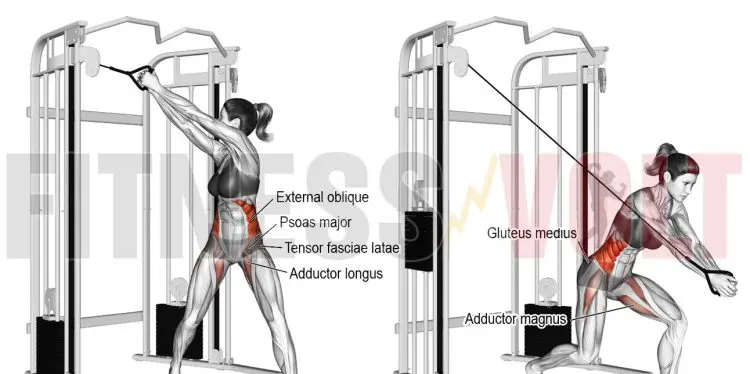
How to do it:
- Attach a D-shaped handle to a high cable pulley machine.
- Stand side-on to the handle and then reach up and grab it. Bend your knees slightly and brace your abs.
- Rotate your upper body through 180 degrees, taking your hands from high to low in a diagonal movement.
- Return to the starting position and repeat.
- You can also do this movement with a more horizontal action by setting the handle to shoulder height or a low-to-high woodchop by putting the handle at about knee height.
Pro Tip: Don’t neglect the importance of hip rotation in this exercise. By pivoting through your hips as you chop, you engage more muscles and increase the movement’s overall effectiveness.
| Difficulty | Beginner to Intermediate |
| Progression | Increase weight, perform standing cable woodchop, vary the cable attachment height |
| Regression | Use a resistance band, perform standing woodchops with a medicine ball or dumbbell |
11. Weighted Side Bend
| Sets & Reps | 3 x 10-12 (each side) |
| Equipment Needed | Dumbbell |
| Target Muscles | Obliques, quadratus lumborum |
Weighed side bends are one of those exercises that many people do wrong. In a misguided attempt to save time and work both sides simultaneously, some lifters hold a dumbbell in each hand.
This means the weights cancel each other out, making this exercise ineffective. So, don’t be a dummy — use one dumbbell to ensure your abs get a more intense workout!
How to do it:
- Stand with your feet about shoulder-width apart, knees slightly bent.
- Hold a dumbbell or kettlebell in one hand.
- Keeping your shoulders and hips square, lean over and lower the weight down the outside of your leg.
- Return to the upright position and, if you wish, lean a little the other way to really fire up your obliques.
- Repeat for the desired number of reps and then swap sides.
Pro Tip: Avoid leaning forward or backward. Maintain a straight spine and focus on laterally flexing your spine to target the obliques effectively.
| Difficulty | Beginner |
| Progression | Cable side bend |
| Regression | Bodyweight side bend |
12. Pallof Cable Press
| Sets & Reps | 3 x 10-15 |
| Equipment Needed | Cable machine with handle attachment |
| Target Muscles | Transverse abdominis, obliques, rectus abdominis, shoulder |
The Pallof press is an anti-rotation exercise. Invented by physical therapist John Pallof, this exercise teaches you to resist unwanted movement. In some ways, it’s like doing a non-rotational plank. This is a useful weighted exercise for athletes and anyone who wants a strong, toned midsection.
Saini recommends progressively increasing the weights on this exercise to maximize muscle stimulation.
How to do it:
- Attach a D-shaped handle to a cable machine and set it to shoulder height.
- Hold the handle and stand sideways onto the machine.
- Bring your hands in close to your chest. Stand with your feet shoulder-width apart and brace your abs.
- Extend your arms in front of you as you resist the rotational pull of the machine.
- Bring your arms back in and repeat.
- Rest a moment, switch sides, and do the same number of reps facing the other way.
Pro Tip: Experiment with different foot positions to vary the challenge. A staggered stance will increase the instability and demand more from your core stabilizers.
| Difficulty | Intermediate |
| Progression | Increase the resistance, perform standing Pallof press with increased hold time |
| Regression | Kneeling Pallof press |
13. Single-Arm Overhead Press
| Sets & Reps | 3-4 sets per arm, 6-8 reps |
| Equipment Needed | Dumbbell or kettlebell |
| Target Muscles | Shoulders (anterior, medial, and posterior deltoids), triceps, core |
All standing overhead pressing exercises involve your core, albeit indirectly. However, unilateral or one-sided exercises like this one-arm press make your midsection muscles work much harder. Engage your abs to keep your torso rigid and upright. This exercise is a great twofer as it simultaneously works your shoulders and abs.
Saini suggests maintaining a neutral wrist position throughout the lift to prevent unnecessary wrist joint strain and allow optimal force transfer.
How to do it:
- Stand with your feet shoulder-width apart, knees slightly bent.
- Raise and hold a single dumbbell or kettlebell to shoulder height.
- Brace your core and pull your shoulders down and back.
- Without leaning to the side, press the weight up and overhead to arms’ length.
- Lower the weight back to your shoulder and repeat.
- You can also do this exercise in a half-kneeling position to take your legs out of the movement and make the weight feel heavier.
Pro Tip: Maintain a slight bend in your knees throughout the movement to avoid unnecessary stress on the lower back.
| Difficulty | Intermediate |
| Progression | Increase weight, perform with a barbell or kettlebell |
| Regression | Seated overhead press, use lighter weight |
14. Weighted Saxon Side Bend
| Sets & Reps | 3 x 10-12 (each side) |
| Equipment Needed | Dumbbell, barbell, medicine ball, or weight plate |
| Target Muscles | Obliques, quadratus lumborum, erector spinae |
Arthur Saxon was a late 19th/early 20th-century German strongman. Famed for his incredible lifting prowess, Saxon also invented several exercises, some of which are still performed today. Saxon side bends are a great way to train your core using a medicine ball, dumbbell, kettlebell, or weight plate.
Keep your shoulders back and down as you bend to prevent the traps from taking over, and ensure the obliques are properly targeted, Saini recommends.
How to do it:
- Stand with your feet shoulder-width apart, knees slightly bent.
- Raise your medicine ball above your head so your arms are straight.
- Without twisting your shoulders or hips, lean over to the left as far as you can and then return to the center. Next, lean over to the right.
- Continue leaning from left to right for the required number of reps.
Pro Tip: Focus on keeping your hips stationary as you bend to ensure the movement is initiated and controlled by your obliques.
| Difficulty | Beginner to Intermediate |
| Progression | Use a barbell instead of a dumbbell, perform standing cable side bends |
| Regression | Bodyweight variation |
Weighted Abs Workouts
While you could just add a couple of these exercises to your usual abs workout, you’ll get better results from a more structured routine. So, here are three short but brutal weighted abs workouts. Do them on non-consecutive days, e.g., Monday, Wednesday, and Friday at the end of your regular strength training program or after cardio.
Save time by performing them circuit style, moving from one exercise to the next without resting. Alternatively, do two to four sets of 12-20 reps of each exercise, resting 60-90 seconds between sets.
| # | Workout one | Workout two | Workout three |
| 1 | Weighted rollout | Weighted V-sit | Weighted knee raise |
| 2 | Windshield wipers | Pallof press | Cable woodchop |
| 3 | Side bend | Farmer’s walk | Single-arm overhead press |
Abs Anatomy 101
There is more to effective abs training than repeatedly hammering the front of your abdomen. In fact, there are several muscles that make up your marvelous midsection:
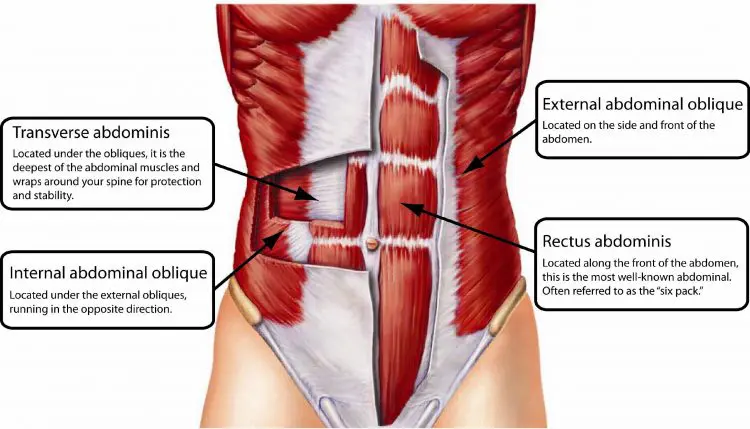
Rectus Abdominus
The rectus abdominus is the long, flat muscle on the front of your abdomen. It’s separated by lines of ligamentous tissue, which give it the six-pack appearance. However, it’s important to note that this six-pack shape is only visible if body fat levels are low enough. How low depends on gender and genetics, but 10% is typical for men and 15% for women.
The main functions of the rectus abdominus are:
- Spinal flexion: bending your spine forward
- Lateral flexion: bending your spine to the side
- Compression of the abdominal contents: such as when you cough or exhale
Obliques
The obliques are located on the side of your abdomen. There are external and internal oblique muscles, but because they work together, most people refer to them as one muscle, simply called the obliques.
The main functions of the obliques are:
- Spinal rotation: twisting your spine
- Lateral flexion: bending your spine to the side
- Compression of the abdominal contents: such as when you cough or exhale
Transverse Abdominus
Where the rectus abdominus runs vertically up the front of your abdomen, the transverse abdominus runs horizontally across it. Acting a lot like a weight training belt, your transverse abdominus encircles your abdominal contents. When it contracts, the TVA increases intra-abdominal pressure to support and stabilize your spine.
While you can’t see the transverse abdominus, no matter how lean you get, it is still a critical muscle. It is involved in every abs exercise, especially those that feature bracing your midsection, i.e., planks.
The main functions of the transverse abdominus are:
- Compression of the abdominal contents, such as when you cough or exhale
- Stabilizing the lumbar spine and pelvis before movement of the lower and upper limbs can occur
Wrapping Up
Bodyweight abs exercises are useful for home exercisers and anyone who travels a lot. Requiring nothing but an exercise mat or folded towel to lie on, you can do bodyweight abs exercises anywhere and anytime, making them the ultimate in excuse-free workouts.
But, you may need more than your body weight to challenge your abs, especially if you are an intermediate or advanced exerciser. And that’s where weighted abs exercises come in.
Using weights means you can train your abs just like any other muscle group, i.e., progressively by adding load and not just doing more reps. This is arguably the most effective way to make your workouts more productive.
So, stop chasing reps with bodyweight exercises and look for ways to increase the weight. Whether you use a weighted vest, dumbbells, a cable machine, or resistance bands, loading up your abs with extra weight will create more muscle tension and make your workouts much more effective. Plus, it will save you from the boredom of doing 100s of reps or planking for five minutes at a time!

